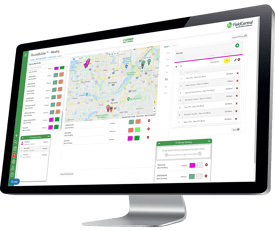By David Crary
Every business no matter the size should have a strategic plan. It is the framework for the company goals and objectives for the year. I have been involved in many strategic plans over the years and the best ones are those that don’t sit on the shelf in a binder but are on the team’s desk or in the truck as a constant reminder of the corporate objectives and goals.  Sometimes the thought of creating a strategic plan is a little intimidating as it is not our strength as business owners. If this is the case, hire a facilitator. There are many skilled individuals that will make the experience thought provoking and rewarding to your business. We use a methodology based on the book Traction to set our strategic vision, set goals, prioritize work and ultimately improve our business.
Sometimes the thought of creating a strategic plan is a little intimidating as it is not our strength as business owners. If this is the case, hire a facilitator. There are many skilled individuals that will make the experience thought provoking and rewarding to your business. We use a methodology based on the book Traction to set our strategic vision, set goals, prioritize work and ultimately improve our business.
If you want to move forward on your own, use the following five tips to help.
- Change the atmosphere. The best planning sessions are when the team gets away from the office. This can be someone’s home or a rented space in a hotel or coffee shop. Just getting away cleans the brain and removes the clutter both physically and mentally. Perhaps one of the most important part is the food. Be sure to feed the team from breakfast items through lunch. Plenty of food makes for a great exchange. At least that was always my experience.
- Start with a vision. What do you want your company to be known for? Is it a culture of innovation with an excellent reputation of strong service? Some companies have very simple vision statements and others work off 5-10 statements. This is up to you. Have your vision statement show your passion for your company. This is exciting. You built the company, embrace the vision and communicate it to your employees, vendors, partners and your customers.
- Perform a SWOT analysis. This outlines the Strengths, Weaknesses, Opportunities and Threats of your business. Think of the strengths and weaknesses as an internal review and the opportunities and threats are external. Brainstorm with your team to really flush these issues out. A Strength might be that your customer service is the best around. How do you know? Because you get countless feedback from your customers that the field reps are respectful, timely and very skilled at what they do. Your customer surveys have proven this time and time again.
- Set Goals. After you have completed the SWOT analysis, goals tend to fall into place. E.g. you want to grow the business so by using the “opportunities” you will likely have identified some growth areas. Perhaps one of your weaknesses is you are over your head in paperwork and don’t have enough time to foster new growth ideas. A goal could be to commit to a field software management system so that you can turn this weakness into an opportunity.
- Map out the Time, Talent and Resources. All the goals will be more effective if you can work through the tactics associated with them. I find it helpful to think of this section as identifying the time, talent and resources needed to accomplish the goal. Your team needs to be 100% committed during this time. They should be working through the “how to accomplish” the goal scenarios. Using the “Field Service Software” example as a goal when will I bring this into the business? (Time) Preferably ahead of my busy time when I can transition. Who is going to be responsible for leading the charge? (Talent) How much will this cost the business? (Resources). This becomes the roadmap and benchmarks that you need to determine if your strategic plan is on pace and you are moving the business forward.
We at Hindsite Software have a simple vision statement: “To improve smallservice contractor businesses”.
If we are true to our vision then everything else will fall into place. Good luck with your planning and don’t forget around 2:00 in the afternoon get up, stretch and then bring in the chocolate…perhaps this is the biggest tip of all!







